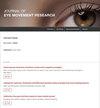SARS-CoV-2 infection impairs oculomotor functions: A longitudinal eye-tracking study
IF 1.3
4区 心理学
Q3 OPHTHALMOLOGY
引用次数: 0
Abstract
Although Severe Acute Respiratory Syndrome Coronavirus 2 infection (SARS-CoV-2) is primarily recognized as a respiratory disease, mounting evidence suggests that it may lead to neurological and cognitive impairments. The current study used three eye-tracking tasks (free-viewing, fixation, and smooth pursuit) to assess the oculomotor functions of mild infected cases over six months with symptomatic SARS-CoV-2 infected volunteers. Fifty symptomatic SARS-CoV-2 infected, and 24 self-reported healthy controls completed the eye-tracking tasks in an initial assessment. Then, 45, and 40 symptomatic SARS-CoV-2 infected completed the tasks at 2- and 6-months post-infection, respectively. In the initial assessment, symptomatic SARS-CoV-2 infected exhibited impairments in diverse eye movement metrics. Over the six months following infection, the infected reported overall improvement in health condition, except for self-perceived mental health. The eye movement patterns in the free-viewing task shifted toward a more focal processing mode and there was no significant improvement in fixation stability among the infected. A linear discriminant analysis shows that eye movement metrics could differentiate the infected from healthy controls with an accuracy of approximately 62%, even 6 months post-infection. These findings suggest that symptomatic SARS-CoV-2 infection may result in persistent impairments in oculomotor functions, and the employment of eye-tracking technology can offer valuable insights into both the immediate and long-term effects of SARS-CoV-2 infections. Future studies should employ a more balanced research design and leverage advanced machine-learning methods to comprehensively investigate the impact of SARS-CoV-2 infection on oculomotor functions.SARS-CoV-2 感染会损害眼球运动功能:纵向眼动追踪研究
尽管严重急性呼吸系统综合征冠状病毒 2 型(SARS-CoV-2)感染主要被认为是一种呼吸系统疾病,但越来越多的证据表明它可能会导致神经和认知功能障碍。本研究使用了三种眼动跟踪任务(自由注视、固定和平滑追逐)来评估轻度感染病例与无症状 SARS-CoV-2 感染志愿者在六个月内的眼动功能。在初步评估中,50 名有症状的 SARS-CoV-2 感染者和 24 名自我报告的健康对照者完成了眼动跟踪任务。然后,分别有 45 名和 40 名有症状的 SARS-CoV-2 感染者在感染后 2 个月和 6 个月完成了任务。在最初的评估中,有症状的 SARS-CoV-2 感染者在各种眼球运动指标上表现出障碍。在感染后的 6 个月中,除自我感觉的心理健康外,感染者的总体健康状况有所改善。在自由观看任务中,感染者的眼球运动模式转向更集中的处理模式,而固定稳定性没有明显改善。线性判别分析显示,即使在感染后 6 个月,眼动指标也能以约 62% 的准确率将感染者与健康对照组区分开来。这些研究结果表明,有症状的 SARS-CoV-2 感染可能会导致持续性的眼球运动功能障碍,而眼动跟踪技术的应用可以为了解 SARS-CoV-2 感染的近期和长期影响提供有价值的信息。未来的研究应采用更均衡的研究设计,并利用先进的机器学习方法来全面调查 SARS-CoV-2 感染对眼球运动功能的影响。
本文章由计算机程序翻译,如有差异,请以英文原文为准。
求助全文
约1分钟内获得全文
求助全文
来源期刊

Journal of Eye Movement Research
OPHTHALMOLOGY-
CiteScore
2.90
自引率
33.30%
发文量
10
审稿时长
10 weeks
期刊介绍:
The Journal of Eye Movement Research is an open-access, peer-reviewed scientific periodical devoted to all aspects of oculomotor functioning including methodology of eye recording, neurophysiological and cognitive models, attention, reading, as well as applications in neurology, ergonomy, media research and other areas,
 求助内容:
求助内容: 应助结果提醒方式:
应助结果提醒方式:


